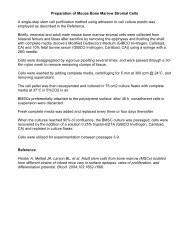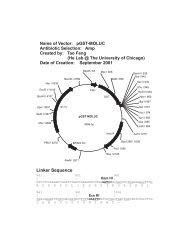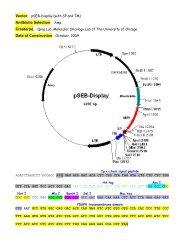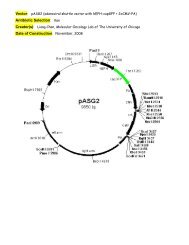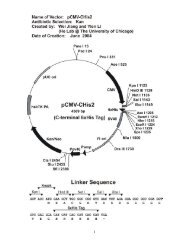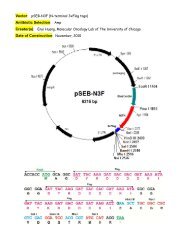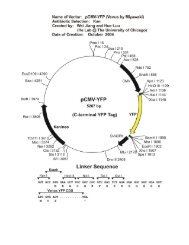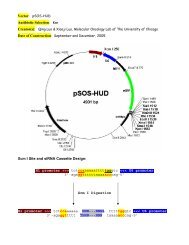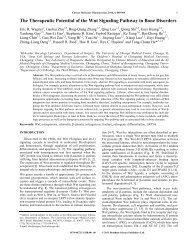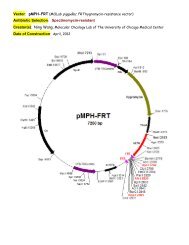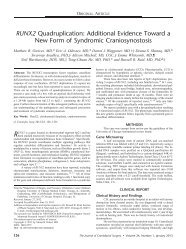Characterization of the distinct orthotopic bone-forming activity of 14 ...
Characterization of the distinct orthotopic bone-forming activity of 14 ...
Characterization of the distinct orthotopic bone-forming activity of 14 ...
Create successful ePaper yourself
Turn your PDF publications into a flip-book with our unique Google optimized e-Paper software.
10:1735–1743). Their findings also suggest that BMP-9 is<br />
one <strong>of</strong> <strong>the</strong> most osteogenic BMPs in rat models <strong>of</strong> <strong>bone</strong><br />
formation.<br />
Acknowledgements<br />
We thank Dr Mark Bolander <strong>of</strong> Mayo Clinic for valuable<br />
discussion and critical review <strong>of</strong> <strong>the</strong> manuscript. We<br />
thank <strong>the</strong> Genetics Institute <strong>of</strong> Cambridge, MA, for<br />
providing human BMP cDNAs. We apologize to <strong>the</strong><br />
researchers whose original work was not cited due to<br />
space constraints. The work was supported in part by<br />
research grants from <strong>the</strong> Aircast Foundation, <strong>the</strong> Brinson<br />
Foundation, North American Spine Society, and <strong>the</strong><br />
Orthopaedic Research and Education Foundation. Q<br />
Kang was a recipient <strong>of</strong> an International Postdoctoral<br />
Fellowship from <strong>the</strong> National Institutes <strong>of</strong> Health (F05<br />
AT0020<strong>14</strong>-01).<br />
References<br />
1 DeWitt N. Bone and cartilage. Nature 2003; 423: 315.<br />
2 Olsen BR, Reginato AM, Wang W. Bone development. Annu Rev<br />
Cell Dev Biol 2000; 16: 191–220.<br />
3 Reddi AH. Role <strong>of</strong> morphogenetic proteins in skeletal tissue<br />
engineering and regeneration. Nat Biotechnol 1998; 16: 247–252.<br />
4 Urist MR. Bone: formation by autoinduction. Science 1965; 150:<br />
893–899.<br />
5 Wozney JM et al. Novel regulators <strong>of</strong> <strong>bone</strong> formation: molecular<br />
clones and activities. Science 1988; 242: 1528–1534.<br />
6 Hogan BL. Bone morphogenetic proteins: multifunctional<br />
regulators <strong>of</strong> vertebrate development. Genes Dev 1996; 10:<br />
1580–1594.<br />
7 Zou H et al. BMP signaling and vertebrate limb development.<br />
Cold Spring Harb Symp Quant Biol 1997; 62: 269–272.<br />
8 Massague J, Weis-Garcia F. Serine/threonine kinase receptors:<br />
mediators <strong>of</strong> trans<strong>forming</strong> growth factor beta family signals.<br />
Cancer Surv 1996; 27: 41–64.<br />
9 Yamashita H, Ten Dijke P, Heldin CH, Miyazono K. Bone<br />
morphogenetic protein receptors. Bone 1996; 19: 569–574.<br />
10 Heldin CH, Miyazono K, ten Dijke P. TGF-beta signalling from<br />
cell membrane to nucleus through SMAD proteins. Nature 1997;<br />
390: 465–471.<br />
11 Massague J. TGF-beta signal transduction. Annu Rev Biochem<br />
1998; 67: 753–791.<br />
12 Wrana JL. Regulation <strong>of</strong> Smad <strong>activity</strong>. Cell 2000; 100: 189–192.<br />
13 Heckman JD, Boyan BD, Aufdemorte TB, Abbott JT. The use <strong>of</strong><br />
<strong>bone</strong> morphogenetic protein in <strong>the</strong> treatment <strong>of</strong> non-union in a<br />
canine model. J Bone Joint Surg Am 1991; 73: 750–764.<br />
<strong>14</strong> Gerhart TN et al. Healing segmental femoral defects in sheep<br />
using recombinant human <strong>bone</strong> morphogenetic protein. Clin<br />
Orthop 1993; 349: 317–326.<br />
15 Lee SC et al. Healing <strong>of</strong> large segmental defects in rat femurs is<br />
aided by RhBMP-2 in PLGA matrix. J Biomed Mater Res 1994; 28:<br />
1<strong>14</strong>9–1156.<br />
16 Bostrom MP, Camacho NP. Potential role <strong>of</strong> <strong>bone</strong> morphogenetic<br />
proteins in fracture healing. Clin Orthop 1998; 355 (Suppl):<br />
S274–S282.<br />
17 Cheng SL et al. In vitro and in vivo induction <strong>of</strong> <strong>bone</strong> formation<br />
using a recombinant adenoviral vector carrying <strong>the</strong> human<br />
BMP-2 gene. Calcif Tissue Int 2001; 68: 87–94.<br />
18 Krebsbach PH, Gu K, Franceschi RT, Ru<strong>the</strong>rford RB. Gene<br />
<strong>the</strong>rapy-directed osteogenesis: BMP-7-transduced human<br />
fibroblasts form <strong>bone</strong> in vivo (in process citation). Hum Gene<br />
Ther 2000; 11: 1201–1210.<br />
The in vivo osteogenic <strong>activity</strong> <strong>of</strong> <strong>14</strong> BMPs<br />
Q Kang et al<br />
19 Partridge K et al. Adenoviral BMP-2 gene transfer in<br />
mesenchymal stem cells: in vitro and in vivo <strong>bone</strong> formation on<br />
biodegradable polymer scaffolds. Biochem Biophys Res Commun<br />
2002; 292: <strong>14</strong>4–152.<br />
20 Riew KD et al. Induction <strong>of</strong> <strong>bone</strong> formation using a recombinant<br />
adenoviral vector carrying <strong>the</strong> human BMP-2 gene in a rabbit<br />
spinal fusion model. Calcif Tissue Int 1998; 63: 357–360.<br />
21 Varady P et al. Morphologic analysis <strong>of</strong> BMP-9 gene <strong>the</strong>rapyinduced<br />
osteogenesis. Hum Gene Ther 2001; 12: 697–710.<br />
22 Varady P et al. CT and radionuclide study <strong>of</strong> BMP-2 gene<br />
<strong>the</strong>rapy-induced <strong>bone</strong> formation. Acad Radiol 2002; 9: 632–637.<br />
23 Helm GA et al. Use <strong>of</strong> <strong>bone</strong> morphogenetic protein-9 gene<br />
<strong>the</strong>rapy to induce spinal arthrodesis in <strong>the</strong> rodent. J Neurosurg<br />
2000; 92: 191–196.<br />
24 Sandhu HS, Khan SN, Suh DY, Boden SD. Demineralized<br />
<strong>bone</strong> matrix, <strong>bone</strong> morphogenetic proteins, and animal models<br />
<strong>of</strong> spine fusion: an overview. Eur Spine J 2001; 10 (Suppl. 2):<br />
S122–S131.<br />
25 Boden SD, Zdeblick TA, Sandhu HS, Heim SE. The use <strong>of</strong><br />
rhBMP-2 in interbody fusion cages. Definitive evidence <strong>of</strong><br />
osteoinduction in humans: a preliminary report. Spine 2000; 25:<br />
376–381.<br />
26 Friedlaender GE. OP-1 clinical studies. J Bone Joint Surg Am 2001;<br />
83-A: S160–S161.<br />
27 Valentin-Opran A et al. Clinical evaluation <strong>of</strong> recombinant<br />
human <strong>bone</strong> morphogenetic protein-2. Clin Orthop 2002; 395:<br />
110–120.<br />
28 Whang K et al. Ectopic <strong>bone</strong> formation via rhBMP-2 delivery<br />
from porous bioabsorbable polymer scaffolds. J Biomed Mater Res<br />
1998; 42: 491–499.<br />
29 Alden TD et al. Percutaneous spinal fusion using <strong>bone</strong><br />
morphogenetic protein-2 gene <strong>the</strong>rapy. J Neurosurg 1999; 90:<br />
109–1<strong>14</strong>.<br />
30 Oyama M et al. Retrovirally transduced <strong>bone</strong> marrow stromal<br />
cells isolated from a mouse model <strong>of</strong> human osteogenesis<br />
imperfecta (oim) persist in <strong>bone</strong> and retain <strong>the</strong> ability to form<br />
cartilage and <strong>bone</strong> after extended passaging. Gene Therapy 1999;<br />
6: 321–329.<br />
31 Alden TD et al. In vivo endochondral <strong>bone</strong> formation using a<br />
<strong>bone</strong> morphogenetic protein 2 adenoviral vector. Hum Gene Ther<br />
1999; 10: 2245–2253.<br />
32 Baltzer AW et al. Genetic enhancement <strong>of</strong> fracture repair: healing<br />
<strong>of</strong> an experimental segmental defect by adenoviral transfer <strong>of</strong><br />
<strong>the</strong> BMP-2 gene. Gene Therapy 2000; 7: 734–739.<br />
33 Baltzer AW et al. Potential role <strong>of</strong> direct adenoviral gene transfer<br />
in enhancing fracture repair. Clin Orthop 2000; 379 (Suppl):<br />
S120–S125.<br />
34 Bosch P et al. The efficiency <strong>of</strong> muscle-derived cell-mediated<br />
<strong>bone</strong> formation. Cell Transplant 2000; 9: 463–470.<br />
35 Breitbart AS et al. Gene-enhanced tissue engineering:<br />
applications for <strong>bone</strong> healing using cultured periosteal cells<br />
transduced retrovirally with <strong>the</strong> BMP-7 gene. Ann Plast Surg<br />
1999; 42: 488–495.<br />
36 Franceschi RT, Wang D, Krebsbach PH, Ru<strong>the</strong>rford RB. Gene<br />
<strong>the</strong>rapy for <strong>bone</strong> formation: in vitro and in vivo osteogenic<br />
<strong>activity</strong> <strong>of</strong> an adenovirus expressing BMP7. J Cell Biochem 2000;<br />
78: 476–486.<br />
37 Gazit D et al. Engineered pluripotent mesenchymal cells<br />
integrate and differentiate in regenerating <strong>bone</strong>: a novel cellmediated<br />
gene <strong>the</strong>rapy. J Gene Med 1999; 1: 121–133.<br />
38 Lieberman JR et al. Regional gene <strong>the</strong>rapy with a BMP-2-producing<br />
murine stromal cell line induces heterotopic and <strong>orthotopic</strong> <strong>bone</strong><br />
formation in rodents. J Orthop Res 1998; 16: 330–339.<br />
39 Lou J, Xu F, Merkel K, Manske P. Gene <strong>the</strong>rapy: adenovirusmediated<br />
human <strong>bone</strong> morphogenetic protein-2 gene transfer<br />
induces mesenchymal progenitor cell proliferation and<br />
differentiation in vitro and <strong>bone</strong> formation in vivo. J Orthop Res<br />
1999; 17: 43–50.<br />
1319<br />
Gene Therapy



